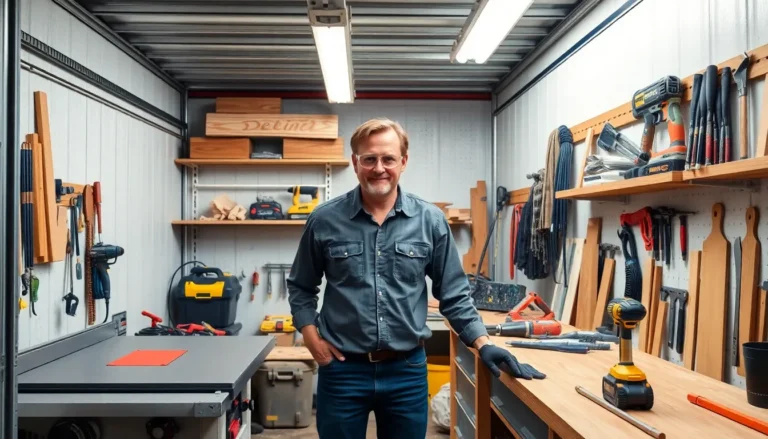Table of Contents
ToggleAustin’s real estate market is hotter than a jalapeño in July, and it’s not slowing down anytime soon. With its vibrant culture, booming tech scene, and live music that makes even the most stoic souls tap their toes, it’s no wonder everyone wants a piece of this Texas pie. As demand soars, so do the trends shaping the market, leaving potential buyers and sellers alike scrambling to keep up.
Overview of Austin Real Estate Trends
Austin’s real estate market remains one of the most dynamic in the United States. Buyers face stiff competition due to the city’s attractive lifestyle and booming industries. High demand drives prices upward, impacting home affordability.
Technology companies, drawn to Austin’s skilled workforce, contribute significantly to market activity. Many new developments arise to accommodate the influx of residents. Urban areas near tech hubs see the most rapid appreciation rates, often exceeding 10% annually.
Rental markets also experience growth. Investors recognize the opportunity to cater to students and young professionals, leading to increased rental property developments. The vacancy rate for rental units consistently hovers around 5%, indicating ongoing demand.
Single-family homes attract particular interest. Properties in desirable neighborhoods sell quickly, often within days of listing. Average days on the market registered at around 30 days, reinforcing the competitive nature of sales.
Condominiums appeal to those seeking lower maintenance options. Younger buyers frequently choose these properties for convenience and access to amenities. Prices for condos also reflect upward trends, showcasing the overall market’s strength.
Changes in mortgage rates impact buyers’ purchasing power. As rates fluctuate, potential homeowners reassess budgets and financing strategies. This volatility creates unique challenges but also opportunities for savvy buyers and sellers.
Overall, Austin’s real estate trends display firm activity characterized by price growth and strong demand. The city’s vibrant culture, tech presence, and population increase continue to shape the market. Adaptability in navigating these trends proves essential for participants in the Austin real estate landscape.
Current Market Conditions

Austin’s real estate market remains extremely active and competitive, driven by strong demand and appealing attributes. Buyers and sellers navigate a landscape shaped by evolving trends.
Average Home Prices
Average home prices in Austin continue to climb, reflecting high demand and limited inventory. As of late 2023, typical single-family homes exceed $500,000, representing a more than 10% increase from the previous year. Buyers often compete in bidding wars, resulting in many homes selling well above the asking price. These increases significantly affect affordability, pushing some prospective homeowners to consider alternative housing options, such as condominiums or townhouses. Investors also find opportunities in the market, leading to a surge in investment properties. Overall, persistent price growth indicates a robust market, making it critical for buyers to act swiftly.
Inventory Levels
Inventory levels in Austin’s real estate market remain tight, contributing to heightened competition. Currently, available listings are down 30% compared to the previous year, further intensifying the struggle for buyers. Sellers often experience multiple offers on properties within days of listing, leading to quick sales. New construction projects aim to address the lack of inventory but struggle to keep pace with demand. The city’s growth encourages investors to develop rental properties, which helps meet the housing needs of the expanding workforce. In this scenario, navigating current inventory levels is vital for both purchasers and investors looking to capitalize on opportunities.
Neighborhood Spotlights
Austin’s diverse neighborhoods cater to various buyer preferences, each with unique characteristics. Popular areas attract buyers seeking vibrant lifestyles alongside convenience and amenities.
Popular Areas for Buyers
Downtown Austin offers a bustling atmosphere with restaurants, shops, and entertainment venues. With median home prices exceeding $600,000, this area appeals to those who crave urban living. The South Congress neighborhood attracts families and young professionals due to its eclectic shops and community feel. Prices here average around $550,000, making it a highly sought-after area. Additionally, the Mueller community stands out for its sustainability initiatives and parks, boasting homes that average $500,000. These popular areas showcase the dynamic nature of Austin’s real estate, reflecting buyers’ preferences for livability and accessibility.
Emerging Neighborhoods
New neighborhoods emerge as significant players in Austin’s real estate landscape. The 78744 area is gaining attention, with home prices averaging $350,000, appealing to first-time buyers and investors. Growth in the area is evident through new developments and community amenities. Likewise, the East Austin area continues revitalizing with unique dining and entertainment options, plus prices around $450,000, attracting creatives and families alike. The North Loop neighborhood also sees interest, offering a blend of vintage homes and modern conveniences, with median prices near $475,000. These neighborhoods present opportunities for buyers looking for value and community, reinforcing Austin’s reputation as an evolving real estate market.
Factors Influencing the Market
Various factors significantly influence Austin’s real estate market, driving trends and shaping buyer behaviors.
Economic Growth and Job Opportunities
Economic growth fuels demand in Austin’s real estate sector. With a thriving tech industry, local job opportunities continue to expand, attracting talent from across the country. Major employers like Dell, Apple, and Tesla contribute to this upward trend. Significant job creation results in increased household income, enhancing buyers’ purchasing power. Investors respond to this growth by developing new properties, further stimulating the market. The competitive landscape means employees often seek homes close to work, increasing demand in surrounding neighborhoods. Consequently, economic stability supports rising home values, impacting affordability and inventory levels.
Migration Patterns
Migration patterns reveal key insights into Austin’s real estate dynamics. A continuous influx of new residents contributes to high demand for housing, significantly shaping local trends. Many individuals relocate to Austin for its vibrant culture, promising job market, and overall quality of life. The U.S. Census Bureau data indicates that, since 2020, Austin has gained thousands of new residents. This trend drives up competition among buyers, leading to bidding wars and quick sales. Additionally, newcomers often seek diverse neighborhood options, further influencing price dynamics across various communities. The consistent population growth ensures ongoing interest in Austin real estate, shaping future market developments.
Future Predictions for Austin Real Estate
Austin’s real estate market shows promising trends influenced by ongoing dynamics. Current conditions indicate a rapidly evolving landscape driven by demand and economic factors.
Short-Term Outlook
Short-term predictions suggest continued price increases, with average home prices likely rising by at least 5% over the next year. Bidding wars may persist due to limited inventory and a competitive buyer pool. High demand in popular neighborhoods reinforces this trend, as homes in areas like Downtown Austin maintain strong appeal. Investors also continue capitalizing on rental opportunities, further tightening the rental market. Future adjustments in mortgage rates can impact affordability, but overall enthusiasm remains strong, promising an active market through the coming months.
Long-Term Projections
Long-term projections highlight sustained growth, with experts predicting home prices could increase by 20% in the next five years. Significant job creation from the tech industry will likely drive population growth, pushing housing demand even higher. Emerging neighborhoods, such as 78744 and North Loop, may see revitalization as affordability remains a priority for buyers. Continued development projects aim to enhance inventory levels, but they may struggle against relentless demand. Sustainable urban planning efforts can help accommodate new residents while maintaining Austin’s unique character, shaping the future of the real estate landscape.
Austin’s real estate market is poised for continued growth and transformation. The combination of a booming tech industry and a vibrant lifestyle attracts new residents, driving demand for housing. As prices rise and inventory remains tight, both buyers and sellers must stay agile to navigate this competitive landscape.
Emerging neighborhoods are becoming increasingly appealing for those seeking affordability without sacrificing access to the city’s culture and amenities. With ongoing developments and urban planning efforts, Austin aims to balance growth while maintaining its unique character.
The future of Austin’s real estate market looks bright, but adaptability will be key for anyone looking to thrive in this dynamic environment.




